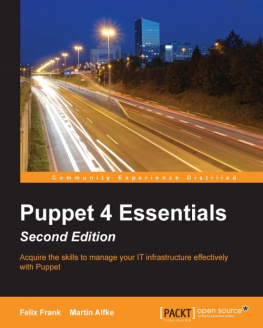Puppet is a configuration management tool that allows you to automate all your IT configurations, giving you control. It was written for and by system administrators to manage large numbers of systems efficiently and prevent configuration drifts..
What this learning path covers
, Puppet 4 Essentials, Second Edition, gets you started rapidly and intuitively as you'll put Puppet's tools to work right away. It will also highlight the changes associated with performance improvements as well as the new language features in Puppet 4. We'll start with a quick introduction to Puppet to get you managing your IT systems quickly. You will then learn about the Puppet Agent that comes with an all-in-one (AIO) package and can run on multiple systems. Next, we'll show you the Puppet Server for high-performance communication and passenger packages. As you progress through the book, the innovative structure and approach of Puppet will be explained with powerful use cases. The difficulties that are inherent to a complex and powerful tool will no longer be a problem for you as you discover Puppet's fascinating intricacies.
By the end of this module, you will not only know how to use Puppet, but also its companion tools Facter and Hiera, and will be able to leverage the flexibility and expressive power implemented by their tool chain.
, Extending Puppet - Second Edition , will be your guide to designing and deploying your Puppet architecture. It will help you utilize Puppet to manage your IT infrastructure. Get to grips with Hiera and learn how to install and configure it, before learning best practices for writing reusable and maintainable code. You will also be able to explore the latest features of Puppet 4, before executing, testing, and deploying Puppet across your systems. As you progress, Extending Puppet takes you through higher abstraction modules, along with tips for effective code workflow management.
Finally, you will learn how to develop plugins for Puppet - as well as some useful techniques that can help you to avoid common errors and overcome everyday challenges.
, Mastering Puppet Second Edition, deals with the issues faced when scaling out Puppet to handle large numbers of nodes. It will show you how to fit Puppet into your enterprise and allow many developers to work on your Puppet code simultaneously. In addition, you will learn to write custom facts and roll your own modules to solve problems. Next, popular options for performing reporting and orchestration tasks will be introduced in this book. Moving over to troubleshooting techniques, which will be very useful. The concepts presented are useful to any size organization.
By the end of this module, you will know how to deal with problems of scale and exceptions in your code, automate workflows, and support multiple developers working simultaneously.
What you need for this learning path
The primary requirements are as follows:
- A Debian GNU/Linux operating system in version 7, code name "Wheezy"
- A Linux system connected to the internet.
- Additional repositories used were EPEL (Extra Packages for Enterprise Linux), the Software Collections (SCL) repository, the Foreman repository, and the Puppet Labs
- An Enterprise Linux 7 derived installation, such as CentOS 7, Scientific Linux 7, or Springdale Linux 7.
- The Latest version of Puppet
Who this learning path is for
If you're an experienced IT professional and a new Puppet user, this course will provide you with all you need to know to go from installation to advanced automation. Get a rapid introduction to the essential topics and then tackle Puppet for advanced automation. Through a practical approach and innovative selection of topics, you'll explore how to design, implement, adapt, and deploy a Puppet architecture.
Reader feedback
Feedback from our readers is always welcome. Let us know what you think about this coursewhat you liked or disliked. Reader feedback is important for us as it helps us develop titles that you will really get the most out of.
To send us general feedback, simply e-mail <>, and mention the course's title in the subject of your message.
If there is a topic that you have expertise in and you are interested in either writing or contributing to a book, see our author guide at www.packtpub.com/authors.
Customer support
Now that you are the proud owner of a Packt course, we have a number of things to help you to get the most from your purchase.
Downloading the example code
You can download the example code files for this course from your account at http://www.packtpub.com. If you purchased this course elsewhere, you can visit http://www.packtpub.com/support and register to have the files e-mailed directly to you.
You can download the code files by following these steps:
- Log in or register to our website using your e-mail address and password.
- Hover the mouse pointer on the SUPPORT tab at the top.
- Click on Code Downloads & Errata .
- Enter the name of the course in the Search box.
- Select the course for which you're looking to download the code files.
- Choose from the drop-down menu where you purchased this course from.
- Click on Code Download











